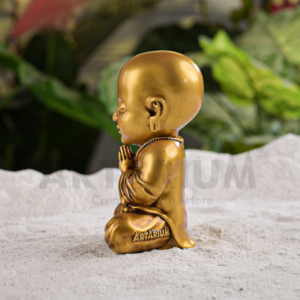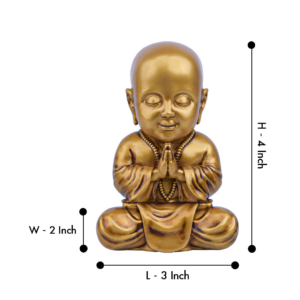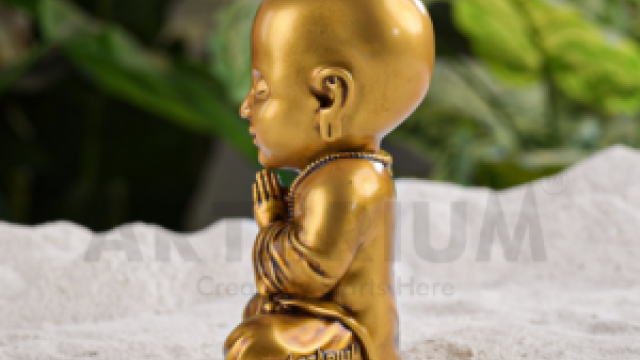Introduction:
In the serene realm of spirituality, the image of the Baby Buddha emanates a sense of profound innocence, purity, and potential. This cherished iconography transcends religious boundaries, capturing the hearts and imaginations of people worldwide. In this exploration, we delve into the enchanting world of the Baby Buddha, uncovering the symbolism, teachings, and universal appeal that make this depiction a timeless source of inspiration.

The Essence of Innocence: Symbolism of the Baby Buddha
At the heart of the Baby Buddha’s symbolism lies the embodiment of innocence and purity. This iconic representation of Siddhartha Gautama, the future Buddha, captures the moment of his birth, an event heralded by auspicious signs and divine blessings. The Baby Buddha signifies the beginning of a journey towards enlightenment, a journey rooted in compassion, wisdom, and the pursuit of truth.
In the imagery of the Baby Buddha, we find the innocence of infancy juxtaposed with the profound potential for spiritual awakening. The tender features, gentle countenance, and serene gaze invite contemplation on the innate purity that resides within each being. It serves as a reminder that the path to enlightenment begins with embracing the innocence and authenticity of the present moment.
Birth and Early Life of Siddhartha Gautama: The Baby Buddha’s Origins
The story of the Baby Buddha begins with the birth of Siddhartha Gautama in Lumbini, Nepal, over 2,500 years ago. According to Buddhist tradition, his mother, Queen Maya, experienced a divine dream foretelling the birth of a great spiritual leader. Siddhartha’s birth was accompanied by miraculous events, including the sprouting of lotus flowers and celestial music.
Raised in the lap of luxury, Siddhartha led a sheltered life within the confines of the palace walls. However, his encounters with the realities of human suffering and impermanence compelled him to embark on a quest for truth and liberation. The story of the Baby Buddha’s early life serves as a timeless parable of awakening, illustrating the universal human journey from ignorance to enlightenment.
The Four Sights: Awakening to the Realities of Life
The journey of the Baby Buddha towards enlightenment was catalyzed by the Four Sights – encounters with old age, sickness, death, and a wandering ascetic. These profound encounters shook Siddhartha to the core, prompting him to confront the impermanence and suffering inherent in human existence.
The Four Sights served as a wake-up call for Siddhartha, compelling him to renounce his princely lifestyle in search of a deeper truth. The story of the Baby Buddha’s awakening underscores the universal human quest for meaning, purpose, and transcendence in the face of life’s inherent challenges.

Renunciation and Spiritual Quest: The Path of the Baby Buddha
The renunciation of worldly comforts marked a pivotal moment in the life of the Baby Buddha. Leaving behind his palace, family, and worldly possessions, Siddhartha embarked on a solitary quest for truth and liberation. For years, he wandered the forests and riverbanks of ancient India, seeking guidance from renowned spiritual teachers and engaging in rigorous ascetic practices.
The story of the Baby Buddha’s spiritual quest embodies the timeless themes of renunciation, perseverance, and unwavering commitment to the path of awakening. It serves as a poignant reminder that true fulfillment and liberation lie not in the pursuit of worldly pleasures but in the cultivation of inner wisdom and compassion.
Enlightenment Under the Bodhi Tree: The Awakening of the Baby Buddha
The culmination of the Baby Buddha’s spiritual journey occurred beneath the Bodhi Tree in Bodh Gaya, India. After years of dedicated practice and unwavering resolve, Siddhartha attained enlightenment, breaking free from the cycle of suffering and delusion. The moment of his awakening, known as the “Great Enlightenment,” marked the birth of the Buddha – the awakened one.
Under the Bodhi Tree, the Baby Buddha experienced profound insights into the nature of existence, unraveling the mysteries of suffering, impermanence, and the path to liberation. His teachings, encapsulated in the Four Noble Truths and the Eightfold Path, offered a timeless blueprint for overcoming suffering and attaining inner peace.
The Universal Appeal of the Baby Buddha: A Source of Inspiration and Hope
The image of the Baby Buddha transcends cultural, religious, and geographical boundaries, resonating with people of diverse backgrounds and beliefs. Its universal appeal lies in its embodiment of innocence, compassion, and the innate potential for spiritual awakening.
For centuries, artists, poets, and seekers have been captivated by the timeless beauty and wisdom encapsulated in the Baby Buddha’s imagery. From ancient sculptures and paintings to contemporary art forms, the Baby Buddha continues to inspire reverence, contemplation, and a sense of awe.
Cultivating the Qualities of the Baby Buddha: Lessons for Everyday Life
The teachings embodied by the Baby Buddha offer profound insights into the human condition and the path to genuine happiness. Its innocence and purity remind us of the importance of cultivating qualities such as compassion, kindness, and mindfulness in our daily lives.
In the midst of life’s complexities and challenges, the image of the Baby Buddha serves as a beacon of hope and inspiration. It invites us to embrace the simplicity and authenticity of the present moment, to nurture our innate potential for goodness and wisdom, and to embark on our unique journeys towards awakening.
Baby Buddha in Art and Culture: A Timeless Muse
The Baby Buddha has been a muse for artists, poets, and storytellers throughout the ages. Across various cultures, representations of the Baby Buddha have adorned temples, manuscripts, and artistic masterpieces, each interpretation offering a unique perspective on the universal themes of birth, life, and enlightenment.
In literature, the Baby Buddha’s story has been retold and reimagined, becoming a source of inspiration for tales of spiritual awakening and the triumph of wisdom over ignorance. Whether in sculpture, painting, or literature, the Baby Buddha continues to be a timeless muse, inviting creators to explore the profound depths of the human spirit.
Contemporary Relevance: Mindfulness and Compassion in a Fast-Paced World
In the hustle and bustle of modern life, the Baby Buddha’s teachings on mindfulness, compassion, and the pursuit of inner peace resonate with increasing relevance. The image serves as a poignant reminder to pause, reflect, and cultivate a deeper awareness of our thoughts, actions, and the interconnectedness of all life.
In a world marked by rapid change and constant stimulation, the Baby Buddha’s innocence becomes a symbol of the purity that exists within each moment. Its teachings encourage us to approach life with a childlike curiosity, to let go of attachments, and to find solace in the simplicity of being.
Conclusion: Nurturing the Inner Baby Buddha Within
In exploring the world of the Baby Buddha, we encounter not only the historical journey of Siddhartha Gautama but also the universal themes of birth, awakening, and the potential for enlightenment that reside within each of us. The innocence and purity symbolized by the Baby Buddha beckon us to rediscover these qualities within ourselves, nurturing the inner child that seeks authenticity, compassion, and a profound connection to the present moment.
As we navigate the complexities of life, the Baby Buddha becomes a timeless companion on our journey – a source of inspiration, guidance, and a reminder that the path to awakening is accessible to all. Its teachings echo across time, inviting us to embrace the innocence, cultivate the wisdom, and embody the compassion that lies within, awaiting our recognition and awakening.




